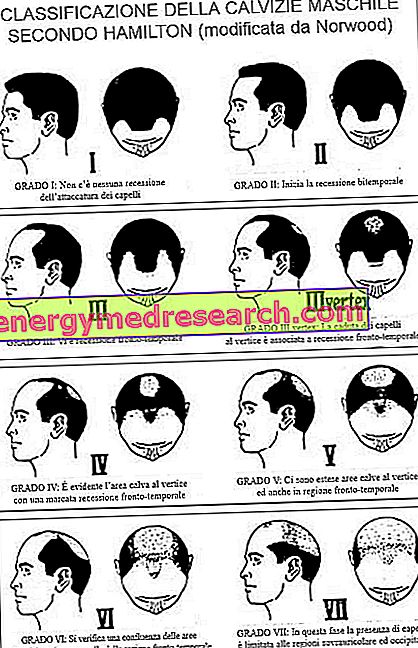Baldness: What it is and what it is not
Baldness, better known as alopecia, is a condition (not a disorder) characterized by progressive thinning of the scalp. In its most common form ( androgenic baldness ), alopecia affects 80% of males and 50% of females at various levels, thus representing a topic of great interest both from a scientific and commercial point of view.
Baldness can affect both sexes and the most widespread form, which mostly affects the male sex, is called androgenic (or androgenetic).
Androgenetic alopecia
Androgenic alopecia - also known as hereditary genetic baldness - is often but not constantly accompanied by seborrhea and furfuraceous desquamation.It occurs, in the initial phase, with a receding or progressive frontal and apical thinning, up to the alopecic involvement of the entire upper part of the scalp, with typical saving of the nape and temporal areas above the ear. The progression of the phenomenon has been codified in the Hamilton scale, with a number ranging from 1 (no trace of alopecia) to 7 (alopecia extended to the whole vertex and to the fronto-temporal region).

Warning! This is NOT a true "loss" of the hair, but rather a structural modification of it; in practice, in androgenetic alopecia the follicles remain long anchored in the scalp BUT they progressively atrophy, slowing down their life cycle, superficializing and making the stem shorter, softer and depigmented, until it becomes invisible (from terminal hair to hair of vellus).
Telogenic Cavity
Another form of baldness is the telogenic one (more technically telogenic alopecia - telogen defluvium ), which can be considered a reflection (or symptom) of the organism to one or more particularly stressful agents, both for the physical and the mind; telogenic baldness affects proportionally more women than men BUT fortunately this is a REVERSIBLE condition.
Other forms of baldness
Then there are other forms of baldness, such as those related to infectious or medicated agents (use of particular drugs, such as antithyroid agents, anorexants, hypervitaminosis A ...); the forms of circumscribed baldness ("in patches") such as alopecia areata or cicatricial must be remembered.
Curiosity : the term alopecia comes from the Greek alopex, which means fox. This term was intended to emphasize the similarity to this animal which notoriously loses hair twice a year.
Female Baldness
As anticipated, androgenic baldness can also affect female sex, albeit with a different distribution of thinning. In both sexes, the incidence increases with age and is influenced by alterations of the steroid hormonal axis; in particular, it often manifests itself parallel to a higher level of typically androgenic hormones (especially dihydrotestosterone ) and / or in the presence of greater enzymatic concentrations of 5-α-reductase (an enzyme that determines the circulating amounts of dihydrotestosterone).
Although the etiological causes of androgenic baldness are not yet fully known, it is conceivable that it may be the result of:
- An increase in dihydrotestosterone levels (hence the term "andro-"), associated with a genetic receptorial hypersensitivity of the hair bulb to their action (hence the term "genetic")
- An imbalance between the growth phases (anagen) and those of involution (catagen) and rest (telogen)
- An inflammation of the scalp
Symptoms and Classification
Androgenic baldness occurs slightly differently between males and females; statistically, in men it affects mainly the temples, while in women mainly the nape.

Treatments and Treatments
The treatment of baldness depends above all on the etiological cause: in the "often" telogenic alopecia it is sufficient to remove the causes of stress to reach an almost total remission.
On the contrary, in the androgenic alopecia it is not possible to obtain the same results; in the male one, some drugs are applied with partial or uncertain results (depending on the specific case) including minoxidil (topical use) and finasteride (os); in women, drugs such as spironolactone antiandrogen, cyproterone or contraceptive pill are used. It is possible to limit the systemic side effects of these drugs by dissolving some active ingredients in special lotions, to be applied directly to the scalp; it is the case of the estrone sulfato (more indicated in women, however risky for the men) or of the topical inhibitors of the 5-alpha-reductase (like the Alfatradiol, however risky for the women of fertile age).
- The earlier the follicle miniaturization process is done, the greater the chances of arresting androgenetic baldness. The chances of therapeutic success are as minor as the onset of the first signs of baldness is earlier; in other words, a male subject who already begins to "lose his hair" after adolescence, has very little chance of halting the phenomenon in the current state of science.
There are also some natural remedies that can be useful to stop androgenic baldness.
In case of advanced alopecia, drug treatment is not recommended because it is ineffective in most cases; in this case, alternative thickening practices or self-hair transplantation (surgical redistribution of the hair bulbs) are recommended.
Read Also: Remedies for Baldness »



